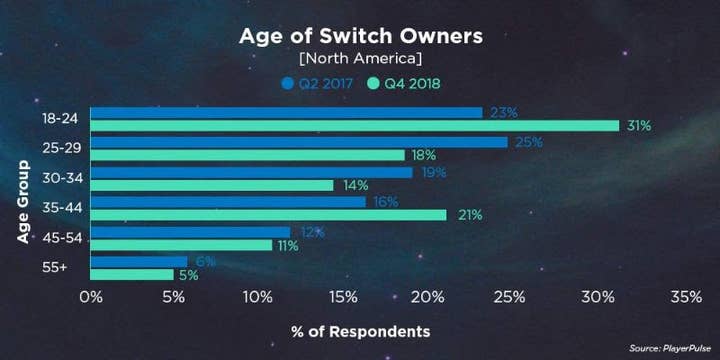EEDAR: Nintendo Switch attracting more women, wider age ranges over time
System on track to follow certain demographic trends of Nintendo predecessors rather than those of console competition
Nearly two years from launch, the demographics of Nintendo Switch owners are beginning to fall more into line with the demographics of other Nintendo system owners, with marked differences from owners of other consoles.
EEDAR's Q4 roundup report (with data from its PlayerPulse consumer tracker survey) showed a breakdown of Nintendo Switch owners in Q2 2017 (shortly after the system came out) compared to owners in Q4 of 2018, demonstrating how early adopters differed from the current set of console owners in terms of gender, age, spending, and amount of time spent playing.
One major, notably distinction is along gender lines. Early adopters of the system were 70% male, and 30% female. Now, the split is 50/50, especially notable as the system tends to attract more women owners than the PS4 or Xbox One.
For comparison, EEDAR provided the splits for other consoles. The PS4 and Xbox One's ownership is 55% male, 45% female, while the Wii U and 3DS had more female owners - 52% and 53% female, respectively. Current Switch numbers indicate that the system may be inclining more toward its predecessors rather than current generation competitors.

Another breakdown offered was by age. Early adopters of the Nintendo Switch tended to be in the mid-20s to mid-30s, but as time has gone on the age range for the system's owners has become spread both older and younger. 31% of owners as of Q4 2018 were under 24, and 21% fell into the 35-44 range.
For comparison again, of PS4 and Xbox One owners, 29% fell into the 24 and under range for both systems. 27% of Wii U owners were under 24, and a whopping 38% of 3DS owners. At the moment, the Nintendo Switch is sitting closer to its console competitors, but the numbers may shift again if Nintendo ends up phasing out the Nintendo 3DS and offers a more kid-friendly Switch option.
In addition, early adopters of the Nintendo Switch tended to spend more time gaming per week (59% spent 11 hours or more), while now the split of time gaming is far more even between 1-5 hours, 6-10 hours, and 11+ hours.

Finally, 40% of early adopters spent between $100 and $249.99 per year on console/PC gaming per year, and were more likely to spend up to $499.99 per year. The current breakdown of Nintendo Switch owners sees 30% in the $.01 to $99.99 per year group, but still 37% in the $100 to $249.99 group, indicating that as a steady average spending range for Switch users.

